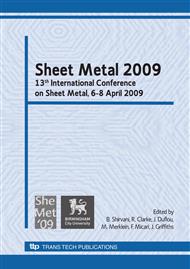p.543
p.555
p.565
p.571
p.579
p.587
p.595
p.601
p.611
Affect of Part Geometry on Wall Features in Rectangular Deep-Drawing Processes Using Finite Element Method
Abstract:
High-quality stamped parts using cost-effective production technique are increasingly required, especially in parts with complex geometry wherein forming defects are easily generated. In this study, the concave and convex wall features were investigated for a stainless steel rectangular tray using the finite element method and related experiments. The concave and convex wall phenomena were theoretically clarified on the basis of stress distribution. The effects of tray geometry were also investigated. Increasing both the rectangle size and depth of tray, together with a decrease in the corner radius, resulted in an increase in concave wall generation. However, the effects of increasing the length or width of the rectangle affecting the concave wall were independent of each other. In addition, the application of a very large depth of tray resulted in a convex feature. The results showed that it is difficult to achieve a straight wall on both the ‘length’ and ‘width’ sides without the use of draw bead. The finite element simulation results showed a reasonable agreement with the experimental results, with reference to the material thickness distribution in both the cases of: absence of the draw bead formation; and presence of the draw-bead formation.
Info:
Periodical:
Pages:
579-585
Citation:
Online since:
March 2009
Authors:
Keywords:
Price:
Сopyright:
© 2009 Trans Tech Publications Ltd. All Rights Reserved
Share:
Citation:


